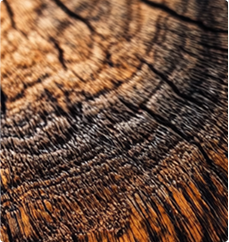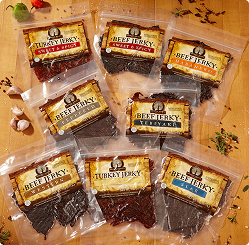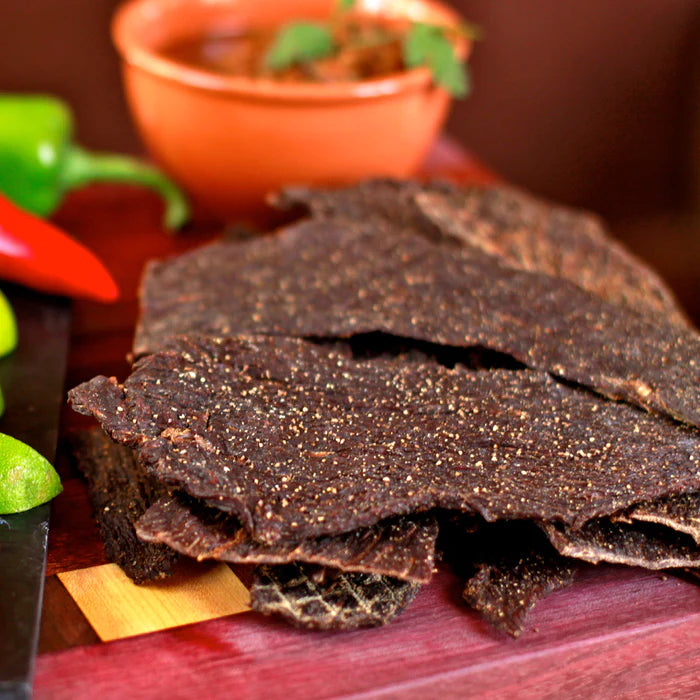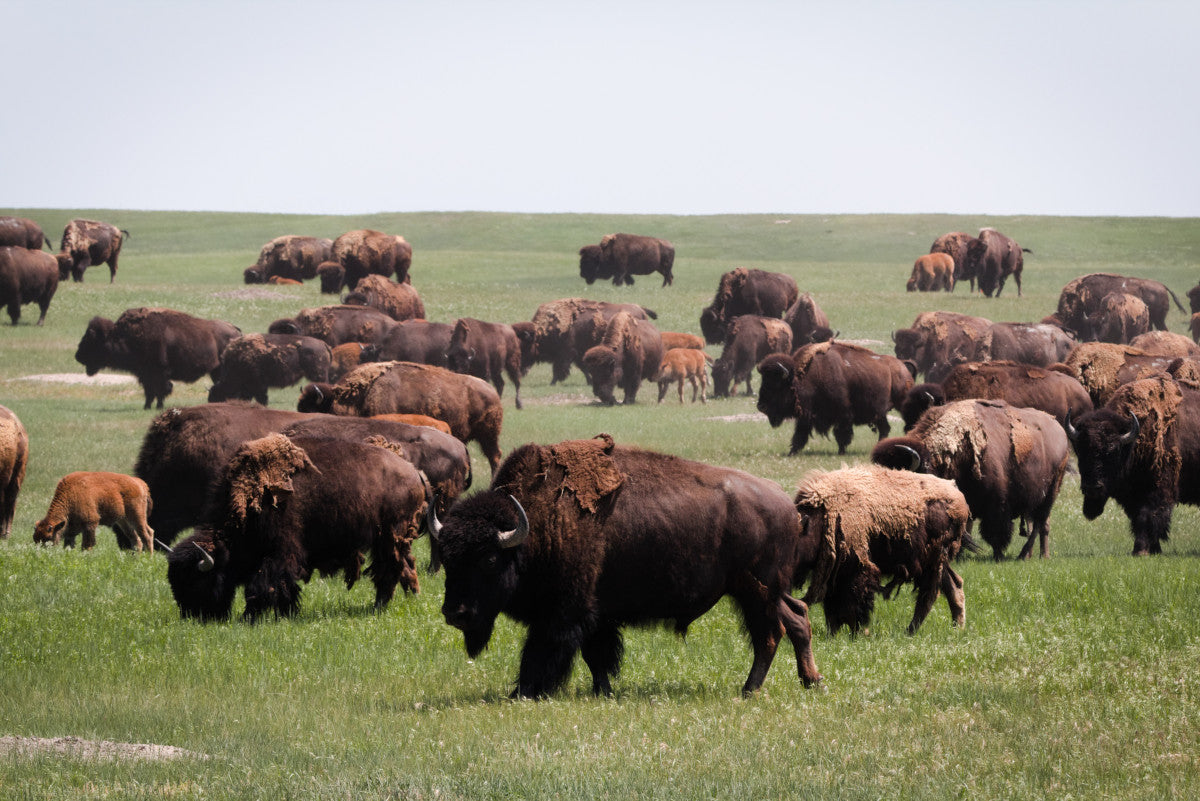Beef jerky has been among the most popular healthy snack choices for centuries. It tastes great and it’s great for you - but it’s also fairly affordable and incredibly convenient. What more could you ask for?
The truth is, though, not all cuts are created equal. For the tastiest, healthiest jerky possible you need to do a bit of digging and uncover the best beef jerky brand. We’re here to help!
Discover what separates the best from the rest below, from ingredient quality and production process to flavor variety, cost considerations, and a whole lot more. We’ll help you gain a solid grasp on what you should look for in the best place to buy beef jerky.
Then, we’ll compare and contrast the top 10 choices on the market right now to point you in the right direction and help you experience this delectable treat to the fullest.
But, if you just want to skip to the good part and get your hands on the best beef jerky online, look no further than Mahogany Smoked Meats.
We’ve been smoking jerky for more than a century using the finest cuts and a small batch process. With our unique mahogany wood smoking method and a wide range of flavors at your disposal, you’ll never find anything like this.
Don’t just take our word for it. Taste the difference today.
What Separates the Best Beef Jerky Brand From the Rest?
With so many different jerky brands at your disposal, distinguishing the best from the rest can feel impossible. But once you know what to look for in a jerky maker it becomes a whole lot easier!
So, what are the most important considerations for someone seeking the best beef jerky on the market? We’ll break down the criteria you should keep in mind below to leave you feeling confident in choosing a brand.
Quality of Ingredients
The most important factor of all is the ingredients that go into bringing the jerky to life. A brand that refuses to cut corners here chooses the best cut for beef jerky.
So, what is beef jerky made from? The best brands tend to rely on top round, known for its lean muscle and tantalizing texture after drying. Other cuts include bottom round, short loin, flank, and brisket.
Beyond the specific cut of meat, its sourcing matters too. It should come from animals raised without antibiotics or growth hormones, favoring grass-fed or organic beef for its richer flavor and higher nutritional content, including beneficial omega-3 fatty acids.
Meat aside, look into the beef jerky marinade recipe to assess what ingredients are used in flavoring. Don’t settle for less here, opt for natural and fresh ingredients over artificial additives, ensuring that each bite of jerky delivers pure flavors true to the meat's origin - all while prioritizing your health and wellbeing.
Flavor and Texture
This one is obvious…the jerky a brand makes has to consistently taste amazing to be in the running for the best beef jerky brand!
From the natural umami of the beef to the carefully balanced spices, smokiness, and subtle sweetness or tanginess in the marinade - there is a delicate dance going on that results in that final flavor.
It’s not just about the actual taste of the jerky, though. Variety matters too. While some prefer the classic teriyaki flavor, others may want something a bit more outside of the box - like a spicy habanero flavor, or a chipotle bourbon flavor. Make sure you can keep things fresh with a variety of flavors so you never get bored of a brand.
But taste is just one piece of the puzzle - texture matters too. It needs to strike a balance between tender and chewy, avoiding overly tough or too brittle consistencies.
This is achieved through precise control of the marination and drying processes so that the jerky is flavorful and satisfying to chew. This is where an understanding of the brand’s production process plays a role, which we’ll talk about in a moment.
But, how can you tell assess the beef jerky’s taste and texture before buying? Turn your attention to the reviews, where you can get a sense of what others experienced firsthand. We’ll talk about reviews in more depth later on as well.
Production Process
The production process of beef jerky is where craftsmanship meets tradition and innovation. So, how is beef jerky made? There are a wide variety of methods brands can employ, but one consistent theme is that it should be slowly smoked and dried.
We talk about the significance of these details in our guides on how long to dehydrate jerky and the optimal dehydrator temp for jerky. It influences the taste and texture.
There’s a fine line between overdone and undercooked. Brands that rush this process in the interest of productivity are compromising on the end result, and it’ll be painfully clear when you take that first bite.
This is also where the specific wood used as part of the smoking process plays a role in the final product. The best wood for smoking jerky ranges from hickory to mesquite, each of which imparts a unique flavor to complement the meat and marinade. That being said, we personally use mahogany - we’ll explain why later on.
The key takeaway should be that the brand you’re considering buying jerky from should be crystal clear about their production process, giving you an in-depth look at what goes on behind the scenes so that you can rest assured you’re getting the quality you deserve.
Nutritional Value
Maybe you’re just interested in the satisfying taste of beef jerky - but chances are, you’re also interested in the health benefits it has to offer. Wait…is jerky good for you? It certainly can be if you take the time to do your due diligence and assess the nutrition facts of a given brand!
Beef jerky is inherently low carb, high in healthy fats, and high in protein. The beef jerky calories can vary but tend to be fairly modest as well, making this a great choice for an afternoon pick-me-up or a post-workout snack.
Take the time to research a brand’s beef jerky nutrition facts beyond the macronutrient breakdown, assessing its sugar content and ability to align with different dietary needs - be it keto-friendliness or gluten-free. Natural, high-quality beef jerky is also high in iron and zinc, crucial minerals for maintaining overall health.
That being said, jerky brands that mass-produce their products will fall short from a nutrition standpoint, sacrificing your health in favor of profits. You can avoid this by ensuring you’re ordering from the best beef jerky brand, like Mahogany Smoked Meats.
Packaging and Presentation
You may assume packaging is nothing more than a vessel for transporting the jerky from the drying rack to your home. However, it serves a more profound purpose in preserving the jerky’s freshness.
Wait, does beef jerky go bad? If so, how long does beef jerky last? Yes, it can spoil. In fact, this is actually a sign of how quality the jerky is. If it never spoils, there’s a good chance the brand is using sketchy preservatives that you don’t necessarily want in your system.
Still, a quality brand takes measures to prolong the shelf life of your jerky through natural preservatives and quality packaging with a vacuum seal. This protects from from moisture and air, the two main culprits responsible for expired beef jerky.
See if the jerky maker has a freshness guarantee for its products. For example, here at Mahogany Smoked Meats we back your order up with a 30-day satisfaction guarantee! Trust us - once you taste that first bite, there’s no chance your jerky will last that long!
Cost Considerations
As you start weighing your options for the best beef jerky brands, you’ll notice that these products cost a bit more than the typical selection you’d find at the gas station or grocery store.
So, why is beef jerky so expensive? Simply put, you get what you pay for. Brands that charge a premium are covering the higher costs that go into creating a better product - from superior ingredients to a slower production process that ensures quality.
But while price is often looked at as an indicator of quality, there’s a bit more nuance here than meets the eye. In general, cheaper beef jerky is going to be lower quality. This is not universally true, though, as some brands do a way better job of balancing cost with quality, which is where value comes into play.
Brand Reputation and Reviews
The best way to feel confident buying beef jerky knowing you’re getting the best of the best is to use other people’s experiences as a guide.
Look for brands with a loyal customer base that receive positive reviews commending their products' flavor, nutritional value, and overall quality. See if you can find common trends rather than looking at single reviews in isolation, which can sometimes be misleading.
These brands will also tend to be more responsive to reviews, known for offering exceptional customer service when necessary, and featured in media coverage.
However, be careful about falling victim to marketing hype or “pay to play” brands that do a great job promoting themselves online only to leave their customers disappointed in their products. This is unfortunately becoming more and more common.
The good news? You can avoid this by following our guidance below on the best jerky brands in 2024! We’ll share our top choices to leave you with a clear understanding of who you can trust in this industry.
So, What is the Best Beef Jerky in 2024?
As we said from the start, there are so many options at your disposal. You can probably get in your car right now and have jerky in your hands within a couple of minutes!
But you’re not just looking for a quick fix, you want the best beef jerky. And it’s just a few clicks away at Mahogany Smoked Meats! Discover the difference yourself by trying our premium jerky today or learn more about what separates our products from the rest below.
Mahogany Smoked Meats
We’ve been perfecting our craft since 1922, with more than a century of experience under out belts. A lot has changed since we first opened our doors, but some things still remain the same - like our passion for producing the finest beef jerky possible.
We’re still in the same Bishop, California storefront we started in and we still use our unique deep log-pit smoking method with mahogany logs, a technique that imbues our jerky with unparalleled depth of flavor and aroma.
Unlike the more common hickory-smoked products, our mahogany-smoked jerky offers a distinctive taste profile, thanks to the dense, aromatic qualities of mahogany wood.
All our jerky is hand-sliced in small batches so we can pay meticulous attention to detail and preserve the artisanal integrity of our products. This hands-on approach guarantees a gourmet experience with every bite, characterized by a rich, smoky flavor that’s both robust and refined.
Plus, you gain access to a wide variety of flavors to choose from, each of which has its place in the pantry:
- Western Beef Jerky
- Peppered
- Teriyaki
- Sweet N' Spicy
- Teriyaki Brisket
- Chipotle Bourbon
- Habanero
- Indian Style
- Cowboy
- Ghost Pepper
Across all these unique flavors you’ll enjoy the same commitment to quality. We only use all-natural ingredients, free from preservatives, nitrites, or MSG. We pack up our products and ship them fast so that you can enjoy your jerky as it was intended - as fresh as possible.
You can also try all the different types of jerky we have to compliment our beef offerings, ranging from elk jerky to fish jerky, wild boar jerky, buffalo jerky, and more.
Our 100% satisfaction guarantee means you can place your order with confidence today knowing you’re truly getting the best beef jerky online. But don’t just take our word for it - see what thousands of others had to say in our reviews:
“This is hands down, the BEST jerky I’ve ever eaten. Vacuum sealed for freshness and oh boy were they fresh. Absolutely delicious. Very flavorful. I will definitely get more. I’m strongly considering a monthly subscription.” - Dean
“Best jerky ever. Chewy and well seasoned.” - Philana
“Hands down the best beef jerky in the world!!!” - Tiffany
“Simply the best and has been since back in the day when it was known as Meadows Farms.” - Steve
“It is so hard to find a good beef jerky this one is the best I highly recommend it!!” - Anthony
Fusion Jerky
Fusion Jerky takes a unique approach to jerky, blending handcrafted Asian-style techniques with global flavors at their Nebraska ranch.
Their sweet beef jerky is a culinary marvel, tenderly braised in strawberry puree, a family recipe that has been perfected over decades. This innovative method results in a flavor and texture that is truly one-of-a-kind.
Beyond the sweet beef, Fusion Jerky offers an array of exotic flavors like chipotle lime, Japanese BBQ, and garlic jalapeno, catering to a broad spectrum of taste preferences and ensuring a gourmet snacking experience.
Hawaiian Tiki Gourmet
Hailing from the aloha state, Hawaiian Tiki Gourmet jerky offers a high-protein snack free from nitrates, nitrites, MSG, and artificial ingredients, emphasizing natural and wholesome goodness.
Their jerky is marinated for 24 hours in house-made concoctions, resulting in an authentic flavor that stands in stark contrast to the superficial taste of spray-on flavored jerkies.
Although their unique flavors like pineapple teriyaki, original, and maui mango are highly sought after, they often sell out quickly. This can be frustrating for those who want to try it out, but it speaks to their popularity and the brand's commitment to quality over quantity.
Vacadillos
Vacadillos pushes the boundaries of traditional jerky with its intensely flavored carne seca, appealing to those who crave the fiery edge of bold spices.
It’s a celebration of Latin American and Northern Mexican culinary traditions, featuring lean strips of steak seasoned with chiles, lime, and other vibrant flavors, then air-dried to perfection.
This brand caters to the thrill-seekers of the jerky world, offering an experience that's not just about snacking but also testing one's mettle against the heat. If you aren’t aware of the differences between beef jerky and carne seca, just read our blog post to learn more.
Bogey’s
Bogey’s Beef Jerky is the brainchild of jerky master Doug Bogumill, whose passion for food experimentation led to the origin of this unique brand. Fueled by creativity and a gift dehydrator from his wife, Doug perfected his craft of blending sauces, spices, and rubs into mouthwatering venison and beef jerkies.
The brand's rise from family and friends' favorite to market fame can be attributed to its distinctive flavors like smokey heat, gnarly gnarly, smokey fire, and pineapple express. Bogey’s offers a gourmet jerky experience, where each bite tells the story of passion and experimentation coming together.
Old Trapper
Old Trapper jerky has been a beloved name in the jerky game for over 50 years. Born in a small Oregon grocery store, the brand has grown to national fame without losing its handmade, authentic touch.
Old Trapper is particularly well known for its original Old Fashioned Beef Jerky, tenderly crafted from lean steak cuts, seasoned with brown sugar, and smoked over real wood.
Their dedication to quality and flavor shines through in each product, including varieties like hot and spicy, traditional, teriyaki, and zero sugar options. Once you find a flavor you love you can stock up with bulk packs as big as 120 oz!
Tillamook
Tillamook Country Smoker brings decades of tradition and quality to their beef jerky. Handcrafted on the Oregon coast, their jerky ranges from silver dollar cuts to innovative zero-sugar options, all smoked over real hardwood.
Tillamook is committed to using only the best cuts of meat to consistently create a tender and flavorful snack. Their flavors include old-fashioned, original, teriyaki, and black pepper, so you can rest assured you’ll find something that aligns with your tastes!
Mojave Jerky Co.
Mojave Jerky Co. offers a premium, handcrafted beef jerky experience, deeply rooted in the Southwest's rich culinary traditions. Known for big, bold flavors, their products reflect the essence of the Mojave Desert, featuring a drier texture and robust chew.
Each batch is made with simple, clean ingredients, including all-natural, locally sourced beef, ensuring a high-protein, soy-free, gluten-free, and keto-approved snack without any preservatives or artificial additives.
Their range includes distinctive flavors like green chile and southwestern, providing a taste of the region’s vibrant and untamed spirit. However, you may feel that you’re limited in this regard compared to other brands that have a seemingly endless number of flavors to choose from.
Cattleman's Cut
Cattleman’s Cut celebrates the essence of American craftsmanship with its array of meat snacks, from legendary flank steak jerky to unique double-smoked sausages. Embracing small-town craft, they deliver big, bold flavors that epitomize American tradition.
Their commitment to quality is consistent across all flavors like original, peppered, teriyaki, texas style, classic smoked, and pepper smoked, each crafted to deliver a satisfying and hearty snacking experience.
Bridgford
Last but not least on our list of the best beef jerky brands, we have Bridgford - a brand backed by the renowned Sweet Baby Ray’s. The brand was awarded the 2008 Men’s Health Nutrition Award, and while it hasn’t seen accolades like this since then, the jerky it produces is still world-class.
As you would expect from a brand powered by a leading BBQ sauce, Bridgford offers a carb-conscious option that doesn’t skimp on flavor.
With varieties like honey BBQ, sweet teriyaki, and convenient sampler packs, they cater to diverse tastes, providing a rich, flavorful experience that’s both satisfying and convenient for on-the-go lifestyles.
Taste the Difference at Mahogany Smoked Meats Today!
That concludes our buyer’s guide to the best beef jerky brand in 2024. We hope you have a clear understanding of not just what separates the best from the rest but also who you can trust to deliver a top-notch culinary experience.
Each brand offers something unique, but at Mahogany Smoked Meats, we pride ourselves on a century-old tradition of crafting jerky with a deep, rich mahogany-smoked flavor that's unmatched in the market.
Whether you’re looking for the best beef jerky or a beef jerky alternative such as the best buffalo jerky or the best fish jerky, remember that Mahogany Smoked Meats is your one-stop-shop.
But why not taste the difference yourself? You be the judge! After all, your order is backed by our 100% satisfaction guarantee. So, shop with us today and discover firsthand what keeps our customers coming back for more.












